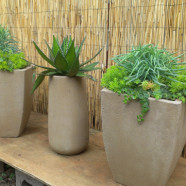
Caring for Succulents,
Succulents (common name) are booming in popularity for two simple reasons: they are beautiful and nearly indestructible. Technically, a succulent is any plant with thick, fleshy (succulent) water storage organs. Succulents store water in their leaves, their stems or their roots.
These plants have adapted to survive arid conditions throughout the world. As a group, succulents include some of the most well-known plants, such as the aloe and agave, and many almost unknown plants. Succulents make excellent display plants in dish gardens. No matter what kind of succulent you’re growing, the rules are pretty similar between the different species. Here are the general rules for growing top-quality succulents: Light: Succulents prefer bright light but may be grown under light shade, however, young plants grow best shielded from direct sunlight.
The color of the plant is a good guide as to whether sunlight should be decreased. Brown spots indicate that the plant is getting sunburned and you should then move the plant to a more shaded area. If new growth on the plant is pale green, the plant needs more light. Move the plant closer to direct sunlight. Try turning the plants on a daily basis so all parts of the plant receive light. Some succulents respond well to incandescent or fluorescent light. Most succulents will thrive outdoors. Water: The potting mix should be allowed to dry between waterings, but do not underwater.
Over-watering and ensuing plant rot is the single most common cause of plant failure A succulent should never be allowed to sit in water. The following are signs of under- or over-watering: • Over watering. Over-watered plants are soft and discolored. The leaves may be yellow or white and lose their color. A plant in this condition may be beyond repair, but you can still remove it from its pot and inspect the roots. If they are brown and rotted, cut away dead roots and re-pot into drier potting media, or take a cutting and propagate the parent plant.
Under-watering: An under watered plant will first stop growing, then begin to shed leaves. Alternatively, the plant may develop brown spots on the leaves. Potting Soils: Succulents should be potted in a fast-draining mixture that’s designed for cacti and succulents. If you don’t have access to a specialized mix, considering modifying a normal potting mix with an inorganic agent like perlite to increase aeration and drainage. These plants generally have shallow roots that form a dense mat just under the soil surface.
Fertilizer: Fertilizer as you would with other houseplants. Use a balanced fertilizer of equal parts Nitrogen, Phosphorous or Potassium


